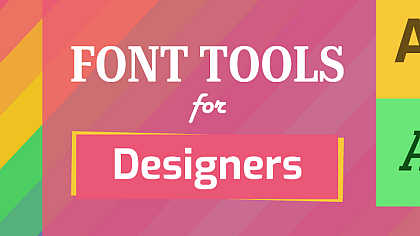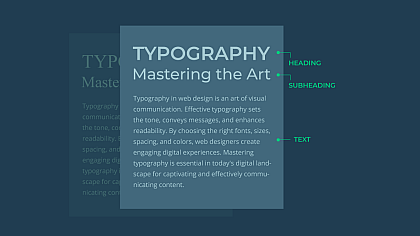
Typography in Advertising: How Font Choices Affect Marketing
Typography plays a crucial role in advertising, influencing consumer perceptions and brand messaging. Explore the impact of font choices on marketing strategies, highlighting how typography can evoke emotions, enhance brand identity, and improve communication with the target audience. Understanding the power of fonts in advertising empowers marketers to create more effective and compelling campaigns.
Why Typography Matters in Advertising
1. Brand Identity: Fonts help reinforce brand personality and recognition. Choosing consistent fonts across ads strengthens brand identity and fosters brand recall. For example, a luxury brand may opt for elegant serif fonts to convey sophistication, while a tech company might use clean and modern sans-serif fonts to appear cutting-edge.
2. Emotional Connection: Different fonts evoke various emotions. Serif fonts exude tradition and elegance, while bold sans-serifs convey modernity and confidence. Script fonts can evoke a sense of creativity and artistry, making them suitable for industries such as design or lifestyle.
3. Readability: Easy-to-read fonts enhance message comprehension and ensure consumers can quickly grasp the advertising content. In digital advertising, where attention spans are shorter, legible fonts are especially crucial to capture and retain interest.
Factors to Consider in Font Selection
1. Target Audience: Understand the preferences and aesthetics that resonate with your target audience to select fonts that appeal to them. A youthful and trendy audience might prefer playful and vibrant fonts, while a more mature demographic may respond better to classic and refined choices.
2. Message Tone: Align font choices with the intended message tone, whether it's authoritative, playful, or sentimental. The font should complement the advertising's overall mood and messaging to create a consistent and impactful experience.
3. Legibility: Avoid overly decorative fonts that hinder readability, especially in small sizes or on digital platforms. Clear and legible fonts ensure that the audience can absorb the content without effort, leading to better engagement.
4. Brand Personality: Ensure the chosen fonts align with the brand's overall personality and values. Consistency in typography helps establish a cohesive brand image and reinforces the brand's positioning in the market.
Impact on Advertising Effectiveness
1. Attention: Eye-catching fonts grab attention and increase ad visibility amidst a sea of competing messages. Bold and unique typography stands out and draws the audience's focus to the advertisement.
2. Engagement: Fonts that resonate with the audience create emotional connections, encouraging higher engagement rates. When the typography aligns with the audience's preferences and feelings, it fosters a stronger bond between the brand and the consumer.
3. Recall: Memorable typography contributes to improved brand recall and recognition. When consumers can easily associate a particular font with a brand, it strengthens brand awareness and increases the likelihood of being remembered.
4. Trustworthiness: Professionally selected fonts enhance the perception of brand credibility and trustworthiness. Fonts that match the brand's values and messaging create a sense of professionalism and reliability in the eyes of the audience.
Example 1: Coca-Cola
Coca-Cola is an excellent example of typography in advertising. The brand uses a custom script font called "Spencerian Script" for its iconic logo. The fluid and elegant script conveys a sense of classic charm and timelessness, aligning with Coca-Cola's brand identity as a beloved and enduring beverage.
Example 2: Nike
Nike's advertising often features bold and impactful typography. The brand uses a custom font called "Nike Futura," which combines a futuristic look with a sense of energy and motion. The font's strong and sleek appearance reinforces Nike's image as a cutting-edge sports brand, inspiring athletes and consumers to "Just Do It."
Example 3: Apple
Apple's advertising is characterized by clean and minimalist typography. The company primarily uses the font "San Francisco" for its marketing materials and product displays. The simple and modern sans-serif font reflects Apple's focus on simplicity, innovation, and user-friendly design.
Example 4: Google
Google's advertising often features the font "Product Sans." This custom font is a contemporary take on the classic geometric sans-serif style, representing Google's commitment to simplicity, clarity, and modern technology. The font is widely used in Google's logo, ads, and other marketing materials.
Example 5: Chanel
Chanel's advertising is known for its use of the "Chanel" font, a refined and elegant typeface with a distinct flair. The font exudes luxury and sophistication, aligning perfectly with Chanel's iconic brand image in the fashion and beauty industry.
Example 6: Airbnb
Airbnb's advertising features a friendly and approachable font called "Cereal." The font's clean and rounded appearance creates a warm and welcoming vibe, reinforcing Airbnb's positioning as a platform that connects travellers with unique and comfortable accommodations.
Example 7: FedEx
FedEx's advertising is famous for its clever use of negative space within the letters of its logo. The custom font in the logo highlights an arrow subtly placed between the "E" and the "x," symbolizing the brand's speed, efficiency, and forward-moving nature in the delivery industry.
Example 8: Disney
Disney's advertising often includes the use of a playful and whimsical font called "Waltograph." The custom font is inspired by Walt Disney's signature and captures the magic and joy associated with Disney's characters and entertainment offerings.
These examples showcase how typography in advertising plays a pivotal role in shaping brand identity, evoking emotions, and effectively communicating messages to the target audience. Each brand carefully selects fonts that align with its core values and resonate with consumers, contributing to the success of their marketing campaigns.
Typography is a powerful tool in advertising, influencing how brands connect with consumers and communicate their messages effectively. By considering the target audience, message tone, and brand personality, marketers can make strategic font choices that elevate the impact of their advertising campaigns and contribute to overall marketing success.
Thoughtful typography enhances brand identity, establishes emotional connections, and leaves a lasting impression on consumers, ultimately driving positive marketing outcomes.











